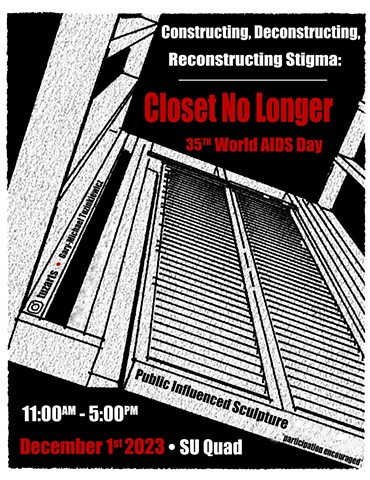HIV|AIDS
Constructing, Deconstructing, Reconstructing Stigma: Closet No Longer
Public Influenced Performative Sculpture by
Gary-Michael Tuzinkiewicz
December 1, 2023
35TH World AIDS Day
General Information + Resource Guide
Information sourced from the CDC - www.cdc.gov/hiv/
WHAT IS HIV/AIDS?
-HIV (human immunodeficiency virus) is a virus that attacks the body’s immune system.
-If HIV is not treated, it can lead to AIDS (acquired immunodeficiency syndrome).
-There is currently no effective cure. Once people get HIV, they have it for life.
-With proper medical care, HIV can be controlled. People with HIV who get effective HIV treatment can live long, healthy lives and protect their partners.
TRANSMISSION
HIV can be transmitted from one person to another when certain bodily fluids are shared between people. Bodily fluids that can transmit HIV include blood, semen, pre-seminal fluid, vaginal fluids, rectal fluids, and breastmilk. HIV can be transmitted during vaginal or anal sex, through sharing needles for injecting drugs or tattooing, by getting stuck with a needle that has the blood of someone with HIV on it, through pregnancy, and through breastfeeding.
PREVENTION
Protecting yourself during sex:
-Condoms are highly effective in preventing HIV and other sexually transmitted infections (STIs), like gonorrhea and chlamydia.
PrEP (pre-exposure prophylaxis) is medicine people at risk for HIV take to prevent HIV.
-Truvada® is for people at risk through sex or injection drug use.
-Descovy® is for people at risk through sex. Descovy is not for people assigned female at birth who are at risk for HIV through receptive vaginal sex.
-Apretude is the only shot approved for use as PrEP. Apretude is for people at risk through sex.
-PEP (post-exposure prophylaxis) is medicine to prevent HIV after a possible exposure. PEP should be used only in emergency situations and must be started within 72 hours after a recent possible exposure to HIV.
Protecting yourself if you inject drugs:
-Never share needles, syringes, or other drug injection equipment
-SEPs (syringe exchange programs)
TREATMENT
-There is no cure for HIV, but you can control it with HIV treatment.
-HIV treatment (antiretroviral therapy or ART) involves taking medicine as prescribed by a health care provider. HIV treatment reduces the amount of HIV in your body and helps you stay healthy. There are two types of HIV treatment: pills and shots.
-Most people can get the virus under control within six months to an undetectable level.
UNDETECTABLE = UNTRANSMITTABLE
Having an undetectable viral load:
-you will not transmit HIV through sex.
-reduces the risk of HIV transmission through sharing needles, syringes, or other injection equipment.
-prevents perinatal transmission.
-greatly reduces the risk of transmitting HIV through breastfeeding but doesn’t eliminate the risk.
STIGMA
-HIV stigma is negative attitudes and beliefs about people with HIV. It is the prejudice that comes with labeling an individual as part of a group that is believed to be socially unacceptable. It affects the emotional well-being and mental health of people living with HIV. People living with HIV often internalize the stigma they experience and begin to develop a negative self-image. They may fear they will be discriminated against or judged negatively if their HIV status is revealed.
-HIV internalized stigma can lead to feelings of shame, fear of disclosure, isolation, and despair. These feelings can keep people from getting tested and treated for HIV.
-HIV stigma is rooted in a fear of HIV.
-The lack of information and awareness combined with outdated beliefs lead people to fear getting HIV.
-Talking openly about HIV can help normalize the subject. It also provides opportunities to correct misconceptions and help others learn more about HIV.
-We can all help end HIV stigma through our words and actions in our everyday lives. Lead others with your supportive behaviors.
LOCAL/STATE/GOV RESOURCES
AIDS Community Resources, Inc.
free HIV/STI testing, PrEP, PEP, SEP
637 West Genesee St, Syracuse, NY 13204
(315)475-2430
AIDS Drug Assistance Program (ADAP)
provides free medications for the treatment of HIV/AIDS
and opportunistic infections
New York State Department of Health
Uninsured Care Programs
1(800) 542-2437 or 1(844) 682-4058
Inclusive Health Services
HIV/STI testing, PrEP, PEP, substance use assessment
Nappi Wellness Institute, Suite 3C
725 East Adams St, Syracuse, NY 13210
(315) 464-5533
New York State AIDS Hotline
HIV/AIDS information
(505) 476-3612
Planned Parenthood – Syracuse Health Center
HIV/STI testing, PrEP, PEP
120 E Genesee Street, Syracuse, NY 13210
(866) 600-6886
Ready, Set, PrEP Program
provides free PrEP HIV-prevention medications
(855) 447-8410 or readysetprep.hiv.gov
Sexual Wellness Center Onondaga County HD
free HIV/STI testing, PrEP
421 Montgomery St, Syracuse, NY 13202
(315) 435-3236
SU - Sexual and Reproductive Health
HIV/STI testing
Barnes Center at The Arch
150 Sims Drive, Syracuse, NY 13244
(315) 443-8000
Together Take Me Home
free mail in HIV/STI self-test
(628) 899-4662 or takemehome.org
